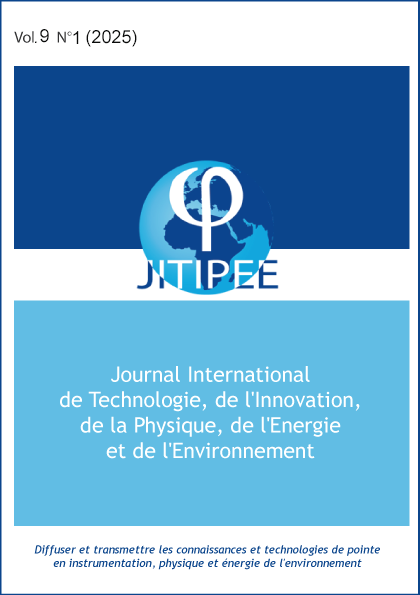Détection des défauts d'arc par radiation électromagnétique utilisant la technologie des antennes
DOI :
https://doi.org/10.52497/jitipee.v9i1.378Résumé
Les défauts d’arc dans les systèmes électriques représentent un risque majeur pour la sécurité et nécessitent des méthodes de détection fiables. Alors que les techniques traditionnelles reposent sur l’analyse du courant, cette étude explore l’utilisation de la radiation électromagnétique émise lors des défauts d’arc pour leur détection. Une antenne fractale de Hilbert de quatrième ordre (HCFA) a été conçue, fabriquée et testée afin de capter les émissions électromagnétiques à large bande générées par les décharges d’arc. Les résultats expérimentaux révèlent une forte corrélation entre les variations brusques de tension et la radiation électromagnétique émise. L’analyse fréquentielle montre que le spectre de radiation est principalement concentré dans les bandes 22–44 MHz et 50–68 MHz. De plus, l’analyse par transformation de Fourier à court terme (STFT) met en évidence les caractéristiques temps-fréquence du rayonnement d’arc, permettant d’identifier précisément son initiation, sa durée et son extinction. Ces résultats confirment la faisabilité de la détection des arcs par radiation électromagnétique et ouvrent la voie au développement de systèmes de surveillance en temps réel basés sur des antennes pour les environnements électriques complexes.
Références
A.H. Omran, D.M. Said, S.H. Abdulhussain, S.M. Hussin, N. Ahmad, (2021) "Models, detection methods, and challenges in DC arc fault: A review", Jurnal Teknologi (Sciences & Engineering) 83(4), 1-16.
https://doi.org/10.11113/jurnalteknologi.v83.15101
H. Zhao, L. Jinpeng, and L. Junchao, (2022) "Series arc fault detection based on current fluctuation and zero-current features.", Electric Power Systems Research, 202, 107626.
https://doi.org/10.1016/j.epsr.2021.107626
K. C. Park, M. Yuichi, and R. Y. Jong, (2017) "Acoustic fault detection technique for high-power insulators.", IEEE Transactions on Industrial Electronics 64(12), 9699-9708.
https://doi.org/10.1109/TIE.2017.2716862
Ö. Baltacı, Z. Kıral, K. Dalkılınç et O. Karaman, (2024) "Thermal image and inverter data analysis for fault detection and diagnosis of PV systems", Applied Sciences 14(9), 3671.
https://doi.org/10.3390/app14093671
Y. Meng, H. Yang, S. Chen, K. Hayat et X. Li, (2024) "A Comprehensive Analysis of Electromagnetic Characteristics for DC Arc Fault Detection", IEEE 69th Holm Conference on Electrical Contacts (HOLM). IEEE, pp. 1-6.
https://doi.org/10.1109/HOLM56222.2024.10768662
Q. Xiong, S. Ji, X. Liu, X. Li, L. Zhu, X. Feng, A.L. Gattozzi et R.E. Hebner (2018) "Electromagnetic radiation characteristics of series DC arc fault and its determining factors", IEEE Transactions on Plasma Science 46(11), pp 4028-4036.
https://doi.org/10.1109/TPS.2018.2864605
G. Gao, X. Yan, Z. Yang, W. Wei, Y. Hu, G. Wu, (2018) "Pantograph–catenary arcing detection based on electromagnetic radiation.", IEEE Transactions on Electromagnetic Compatibility 61(4), pp 983-989.
https://doi.org/10.1109/TEMC.2018.2841050
Charles J Kim, (2008) "Electromagnetic radiation behavior of low-voltage arcing fault", IEEE transactions on power delivery 24(1), pp 416-423.
https://doi.org/10.1109/TPWRD.2008.2002873
J. Anguera, A. Andújar, J. Jayasinghe, V. V. S. S. S. Chakravarthy, P. S. R. Chowdary, J. L. Pijoan, T. Ali and C. Cattani (2020) "Fractal antennas: An historical perspective", Fractal and Fractional 4.1 4(1), p 3.
https://doi.org/10.3390/fractalfract4010003
N. Sharma and V. Sharma, (2017). "A journey of antenna from dipole to fractal: A review", J. Eng. Technol 6.2 6(2), pp 317-351.
M. V. Rusu and B. Roman, (2010) "Fractal antenna applications" Microwave and millimeter wave technologies from photonic bandgap devices to antenna and applications. IntechOpen,
https://pdfs.semanticscholar.org/0d91/0acfe632fb9028b47c8515c341851e8f0d26.pdf
R.R. Boopathi, (2020) "A compendious review on fractal antenna geometries in wireless communication.", 2020 International Conference on Inventive Computation Technologies (ICICT). IEEE, ICICT, pp. 888-893.
https://doi.org/10.1109/ICICT48043.2020.9112580
A.J.H. Al-Saedi, J.C. Perez, (2022) "A Review: Microstrip Fractal antenna geometries.", Przegląd Elektrotechniczny 98.
X. Yang, J. Chiochetti, D. Papadopolous, L. Susman, (1999) “Fractal Antenna Elements and Arrays”, Applied Microwave &Wireless, 11, pp 34-46.
S. Tripathi, A. Mohan, S. Yadav, (2017) "A compact UWB Koch fractal antenna for UWB antenna array applications" Wireless Personal Communications 92
https://doi.org/10.1007/s11277-016-3613-1
E.C. Lee, P.J. Soh, N.B.M. Hashim, G.A.E. Vandenbosch, V. Volski, I. Adam, H. Mirza, M. Aziz, (2011) "Design and fabrication of a flexible Minkowski fractal antenna for VHF applications", Proceedings of the 5th European Conference on Antennas and Propagation (EUCAP). IEEE, pp. 521-524.
https://ieeexplore.ieee.org/abstract/document/5782481
A. Singh, S. Singh, (2016) "Design and optimization of a modified Sierpinski fractal antenna for broadband applications.", Applied Soft Computing 38, pp 843-850.
https://doi.org/10.1016/j.asoc.2015.10.013
D. Froumsia, S.W. Yao, E.D. Jean-François, H. Alphonse, Kolyang, M. Inc (2022) "A review of the miniaturization of microstrip patch antenna based on fractal shapes", Fractals 30(05), 2240161.
https://doi.org/10.1142/S0218348X22401612
W. SikorSki, C. Szymczak, K. Siodła, F. Polak, (2018) "Hilbert curve fractal antenna for detection and on-line monitoring of partial discharges in power transformers", Eksploatacja i Niezawodność, 20(3), 343-351.
https://bibliotekanauki.pl/articles/300766.pdf
ANSYS, Inc. (2024). ANSYS HFSS - High Frequency Structure Simulator. [Online]. Available: https://www.ansys.com/products/electronics/ansys-hfss.
Y. Yin, S. Li, X. Yan, X. Zhao, Z. Lv, Y. Liu, (2023) "Design of Hilbert Fractal Antenna for Partial Discharge Detection in Cable Joints", International Conference on Wireless Power Transfer. Singapore: Springer Nature Singapore, pp. 19-27.



